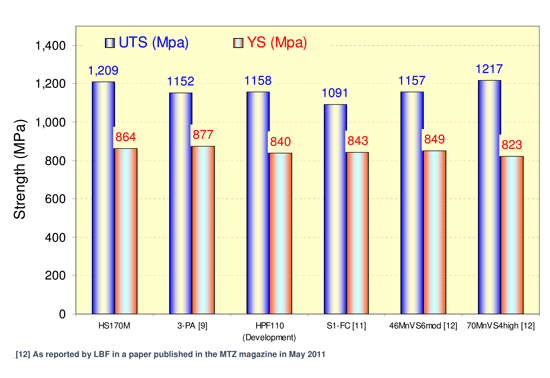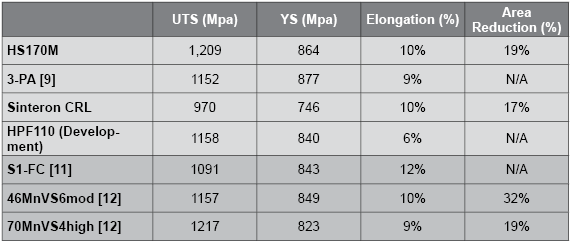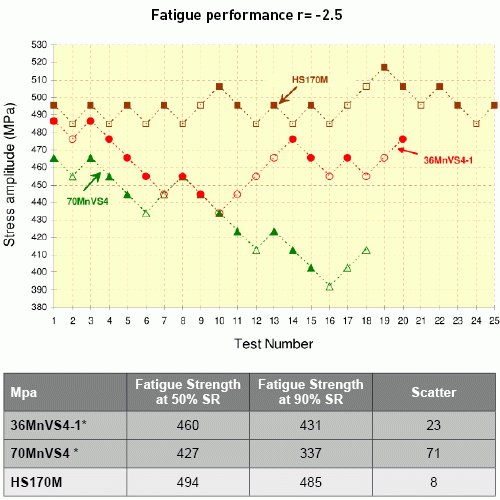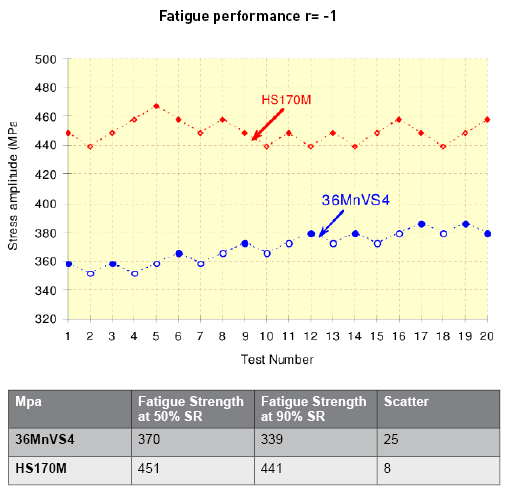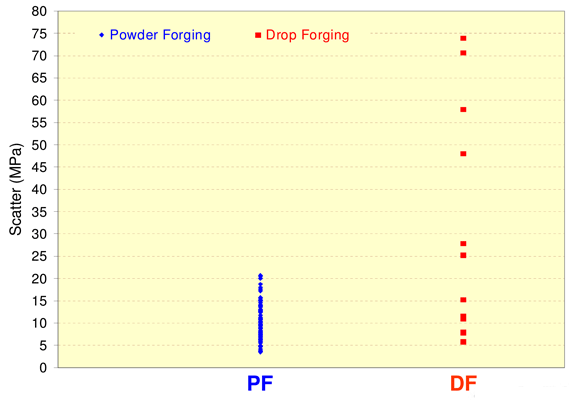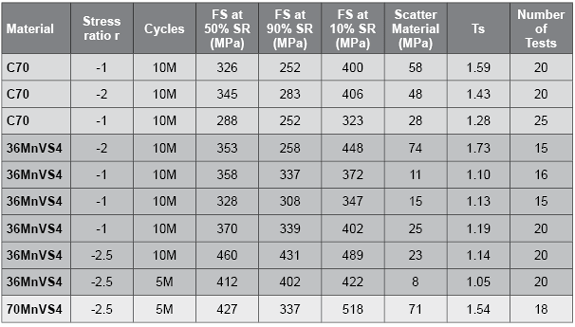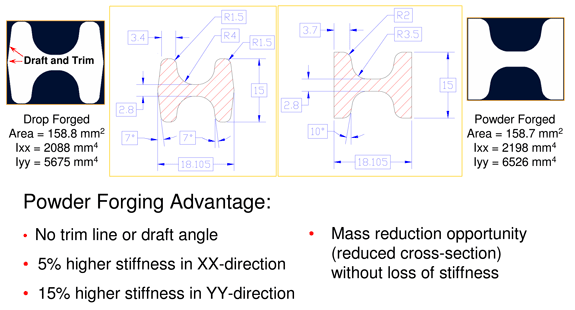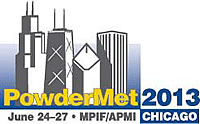PowderMet 2013: Powder forging demonstrates superiority in the connecting rod competition
Practically ever since the emergence of Powder Forging as a viable means of manufacturing automotive connecting rods some 35 years ago, there has been continuing debate on its merits relative to the main competing technology of open die drop forging.
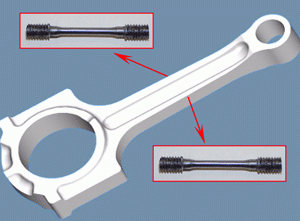
Fig. 1 Cylindrical specimens machined from the
I-beam of PF connecting rods manufactured
with HS170M
In the presentation by Edmond Ilia the comparison of the two competitive process routes was set in the context of their relative responses to the increasing demand from automotive OEMs for higher strength connecting rod materials in order to enable the light-weighting of rods or the use of a given size of rod in a higher performance engine.
Ilia first described the range of higher strength material grades that have emerged from the Powder Forging (PF) industry’s response to this challenge. These have included:-
- New optimised grades introduced by Metaldyne themselves, with copper contents ranging from 3 to 3.5% (HS150M, HS160M and HS170M), that have higher and more consistent mechanical properties than the previous standard 2%Cu material.
- Materials developed by GKN that use a base iron powder pre-alloyed with 3% copper to homogenise the strengthening effect of the copper (3-PA). Additional copper can be introduced into this base material, as desired, through an elemental addition.
- A material, introduced by Sinteron in collaboration with Höganäs AB, that is based on the pre-alloyed Astaloy CrL grade.
The Drop Forging (DF) industry’s initial material development was aimed at offering higher strength and at attacking PF’s perceived competitive advantage of big-end cap fracture splittability, explained Ilia. This material, a modified C70 (AISI 1070) grade, raised carbon content from the previous norm of 0.4-0.5% to 0.7%. The effects of this carbon content increase were to increase strength, to confer fracture splittability, but to sacrifice some machinability.
More recent developments in DF connecting rod materials have been aimed at further strength enhancements, retention of fracture splittability and, in some cases, attacking the machinability limitation. These grades have included:-
- 36MnVS4, a material with lower carbon content to aid machinability and with a micro-alloying addition of vanadium and increased molybdenum content to increase strength.
- Other vanadium micro-alloyed grades, 46MnVS6mod (0.46%C, 0.63%Si, 1.02%Mn, 0.26%Cr, 0.20%Ni, 0.13%V and 70MnVS4high (0.70%C,0.20%Si, 0.83%Mn, 0.15%Cr, 0.14%Ni, 0.19%V).
- A material, developed by Hyundai, in which the carbon content in C70S6 was reduced and the silicon content was increased. Vanadium was also added to this grade to increase strength.
The tensile properties of several of these high strength PF and DF grades were measured on test-pieces taken from the I-beam sections of forged connecting rods as shown in Fig. 1.
The results of these tensile tests are shown in Table 1 and Fig. 2. As can be seen from these results, these high strength grades were mainly quite comparable with one another in terms of tensile properties.
However, Ilia stated that a much more interesting comparison emerged in terms of axial fatigue properties, which is a more relevant comparison as fatigue is the critical criterion in designing connecting rods.
In these tests the fatigue strengths of the DF grades 36MnVS4 and 70MnVS4 were compared with the PF grade, HS170M.
Ilia stated that the results of tests conducted using the staircase method, as defined in MPIF Standard 56, and at a stress ratio, R, of -2.5, demonstrate the superiority of HS170M in terms both of the fatigue strength at 90% probability of survival and of the scatter in results (Fig. 3). The 90% probability of survival value is the most commonly used parameter in connecting rod design and the degree of scatter controls the level of safety factor that must be applied to the resulting design.
The superiority in fatigue performance of HS170M over that of 36MnVS4, in terms of both strength at 90% probability of survival and of degree of scatter, was even more marked in fully reversed (R= -1) tests, as demonstrated in Fig. 4.
The observed high level of scatter in fatigue performance is quite typical of reported data on drop forged connecting rods, stated Ilia (Table 2). The comparative variations in fatigue test results, reported for PF and DF rods are shown graphically in Fig. 5. The low level of scatter and, hence, of required safety factor, gives the PF grades a significant edge in terms of the capability for light-weighting in design, he said.
Scanning electron microscopy studies of fracture faces after fatigue testing revealed the underlying reason for the high scatter in strength of DF rods, stated Ilia. These studies revealed the presence of forging defects, particularly along the trim line, such as oxides, folds and micro-cracks (Fig. 6), which can act as crack initiators.
A further source of potential weight reduction in PF rods was revealed in discussing issues related to “design for the process”. For instance, because there is no requirement to allow for draft angles or trim lines, the I-beam section of a PF rod is smoother than a DF rod (Fig. 7). Also, the inner radius in the web can be smaller for a PF rod, making possible a better mass distribution in the outer corners of the section where its contribution to stiffness is higher, added Ilia.
In the conclusion to the presentation other competitive advantages of PF rods over DF rods were enumerated by Ilia (although without supporting quantitative data):-
- Higher material ulilisation
- Better weight variation control (of significance in relation to NVH considerations)
- Better machinability
- Reduced numbers of machining operations
- Lower deformability during the fracture splitting process
- Lower overall cost in the finished machined product
Overall, the presentation provided compelling reasons for choosing the Powder Forging route.
Author
Dr David Whittaker is a consultant to the Powder Metallurgy and associated industries. Contact +44 1902 338498 email: [email protected]
PowderMet2013 was organised by the Metal Powder Industries Federation. For more information please visit the MPIF website: www.mpif.org
News | Articles | Market reviews | Search directory | Subscribe to e-newsletter



